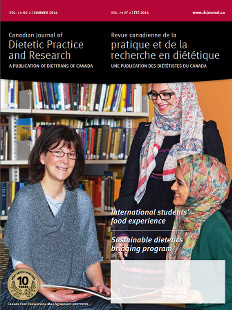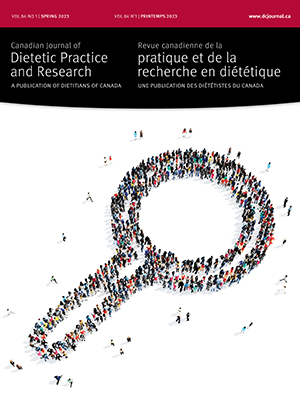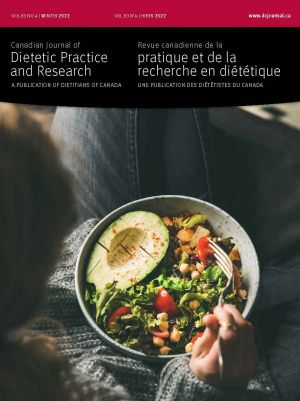Volume 75 • Number 2 • July 2014
Chair’s Message
Editor’s Message
Research
Purpose: International student enrolment in Canadian universities is increasing. As international university students acculturate, they experience a culture shock in which food plays a major role. International university students’ Canadian food experiences therefore were explored. Methods: A Photovoice methodology was used with 15 international undergraduate and graduate university students, who were recruited to take pictures of their food experiences. They also participated in two focus group discussions that included an analysis of their photos. Results: Seven themes related to the significance of food in acculturation were revealed: the paradox of Canadian convenience, the equation of traditional foods with health, traditional food quality and accessibility, support networks, food consumption for comfort, ethnic restaurants, and the exploration of non-traditional foods. Maintaining cultural identity with traditional foods was an overarching theme related to acculturation. Conclusions: International students acculturating to Canada have emotional and physical needs, which can be met through food. Opportunities exist to improve their acculturation experiences. Canadian universities can incorporate food acculturation strategies into campus events and menus. Nutrition professionals on campus can facilitate a positive food environment and nurture culture identity formation.
Purpose: Changes were examined in energy intakes and percentage of energy from macronutrients in response to nutritional intervention in women with gestational diabetes mellitus (GDM). Methods: The study included 17 women with GDM and 27 women with normal glucose tolerance (controls). Women with GDM were followed by a multidisciplinary team; they received dietary counselling by a registered dietitian, and were prescribed diets with 40% to 45% energy from carbohydrate (CHO), 20% to 25% from protein, and 30% to 35% from fat. Dietary intakes were assessed with food frequency questionnaires before the intervention (26.9 ± 3.8 weeks) and after the intervention (32.6 ± 0.6 weeks). Results: After the intervention, women with GDM reduced their total energy intake to reach lower values than did controls (P value for time-group interaction ≤0.05). A concomitant reduction in total CHO and glucose intakes in women with GDM led to significantly lower values compared with intakes in controls (P values for time-group interaction ≤0.001 for all). The post-intervention rate of weight gain in women with GDM was within the Institute of Medicine (IOM)-recommended values, while the post-intervention rate of weight gain in controls was above IOM-recommended values (0.30 ± 0.27 versus 0.61 ± 0.50 kg/week, P≤0.05). Conclusions: These results suggest that this multidisciplinary medical and nutritional intervention was effective in the achievement of prescribed macronutrient distribution and controlling gestational weight gain in Canadian women with GDM.
Purpose: The short-term effectiveness of the nutrition-centred Complete Health Improvement Program (CHIP) lifestyle intervention for improving selected chronic disease risk factors was examined in the Canadian setting. Methods: A total of 1003 people (aged 56.3 ± 12.1 years, 68% female) were self-selected to participate in one of 27 CHIP interventions hosted in community settings by Seventh-day Adventist churches throughout Canada, between 2005 and 2011. The program centred on the promotion of a whole-food, plant-based eating pattern, and daily physical activity was also encouraged. Biometric measures, including body mass index (BMI), blood pressure (BP), blood lipid profile, and fasting blood sugar (FBS), were determined at program entry and 30 days into the intervention. Results: Over 30 days, significant overall reductions (P<0.001) were recorded in the participants’ BMI (-3.1%), systolic BP (-7.3%), diastolic BP (-4.3%), total cholesterol ([TC] -11.3%), low-density lipoprotein cholesterol ([LDL-C] -12.9%), triglycerides ([TG] -8.2%), and FBS (-7.0%). Participants with the highest classifications of TC, LDL-C, TG, and FBS at program entry experienced approximately 20% reductions in these measures in 30 days. Conclusions: The CHIP intervention, which centres on a whole-food, plant-based eating pattern, can lead to rapid and meaningful reductions in chronic disease risk factors in the Canadian context.
Purpose: The role of registered dietitians (RDs) in decisionmaking for percutaneous endoscopic gastrostomy (PEG) placement was explored. The ethical climate in their workplace and the relationship between decision-making and the ethical climate were examined. Methods: The survey included 67 RDs in complex continuing care and long-term care settings in Ontario. Descriptive statistics were used to describe roles, ethical climate, and professional characteristics. Pearson's and nonparametric correlations were used to examine relationships between roles, ethical climate, and professional characteristics. Results: Among the respondents, 97% thought RDs had a role in decision-making processes. The majority of RDs were usually or always involved in two roles: identifying relevant nutrition issues (91.2%) and discussing feeding options and alternatives (80.7%). Dietitians’ roles in decision-making processes were more extensive when their relationship with physicians was positive (r=0.321, P=0.016), they had adequate knowledge (r=0.465, P<0.001) and adequate skills (r=0.520, P<0.001), and they were more satisfied with their role (r=0.554, P<0.001). Conclusions: Registered dietitians performed a variety of roles in decision-making processes concerning PEG placement in the elderly. A positive working relationship with physicians, knowledge, skills, and role satisfaction significantly increase RDs’ involvement with patients and families.
Purpose: The role of nutrition in older men’s health and successful aging has been inadequately studied. We examined the relationships among nutritional risk, self-rated health, and successful aging in community-dwelling Canadian older men. Methods: The surviving cohort of the Manitoba Follow-up Study (n=690, mean age = 86.8 years) were sent a selfadministered nutrition survey in December 2007. The survey consisted of the Seniors in the Community: Risk Evaluation for Eating and Nutrition, version II (SCREEN II), a validated tool for assessing nutritional risk of cognitively intact community-living older adults, and questions about successful aging and health. Results: Of the 553 surveys returned (80% response), 522 with complete SCREEN II data were included in the analysis. Forty-four percent of respondents were at high nutritional risk, 24% were at moderate risk, and 32% were at low risk. Significant relationships were found between nutritional risk and self-rated health (P<0.0001) and successful aging (P=0.008), with greater nutritional risk associated with lower self-ratings of health and successful aging. Higher use of prescription medication was related to greater nutritional risk (P=0.004). Conclusions: Nutritional screening programs for communitydwelling older men are warranted as two-thirds of the study participants were at nutritional risk. Identifying older men at nutritional risk is a critical step in the process of nutritional assessment, and subsequent nutrition interventions and followup are required to prevent further health decline.
Purpose: University nutrition students’ experiences of participation in an arts module as part of a senior nutrition course were explored to gain an understanding of the relationship of art to dietetics practice. Methods: The module comprised discussions, readings, and presentations from dietitian artists, along with three assignments: the production of art, an artist statement, and a reflection paper. The art production depicting an aspect of body image was presented to the class and optionally at a body image conference. An exploratory, qualitative methodology informed by Schön’s reflective practice framework was employed. Three surveys administered at various times during the arts module were used to collect students’ reflections and were thematically analyzed. Results: Three themes emerged: hesitance to acceptance, emotion and connection, and relationship with dietetics. The education process facilitated a transformation among students, noted as changes in knowledge, perceptions, and attitudes over the course of the module. Conclusions: The arts provide an alternative platform for an exploration of self and others, for improving practice, and for an examination of novel ways for doing so. Reflection as an education component enables students to contemplate relationships, knowledge, emotions, and practice as interrelated and evolving entities.
Perspectives in practice
A provincial focus on immigration and improved foreign credential recognition has led to an investigation of best practices and subsequent recommendations for the development and implementation of a sustainable university-based bridging program for internationally educated dietitians in Atlantic Canada. Data were collected from various sources and used to inform program decisions and direction. An advisory framework was established through a core group representing dietetics education and regulation and internationalization. Subsequently, a key stakeholder group was formed. As a result of this collaboration and research, a dietetics bridging framework was developed and a program pilot tested. Lessons learned may inform similar endeavours and highlight the importance of collaborative leadership and collaboration among multiple stakeholders, and of creatively addressing program sustainability issues while keeping learners (internationally educated dietitians) at the centre.
With the aim of enhancing dietetics education in Nova Scotia, key stakeholders were engaged in identifying current practice issues along with opportunities for collaboration to address them. A survey containing five open-ended questions was distributed by email to a purposive sample of 24 participants affiliated with three universities with dietetics programs. Participants fell into five categories: internship coordinators, dietetics educators, recent internship graduates, current interns, and prospective interns. The response rate was 58%. Data were thematically analyzed through a process of constant comparison. Primary themes emerged, which reflected survey participants’ concerns about three current practice issues: province-wide standards, internship placement availability, and the overall educational experience. Additional comments suggested that overall dietetic educational experiences could be improved if relevant clinical experiences were offered and preceptor workloads were accommodated. The creation of province-wide standards for assessing interns’ level of competency was perceived to offer multiple benefits, including decreased preceptor workloads. Participants believed that collaborative actions might increase internship placements and improve the overall dietetic internship experience for interns and preceptors.
We conducted a group interview with five hemodialysis patients of Acadian descent. Our purpose was to learn about their intakes of Acadian foods so we could tailor our advice for other Acadian patients receiving hemodialysis. This approach builds on evidence that addressing cultural aspects of food choice and aligning dietary recommendations with usual intakes create optimal conditions for diet adherence while preserving personal habits and heritage. In this study, “the Acadian diet” held multiple meanings for different participants, participants varied in their intakes of traditional Acadian foods, intakes of traditional Acadian foods were decreasing in younger generations, and the desire to preserve kidney function had priority over eating much-loved traditional foods. These findings support the practices of individualized nutritional and dialysis care and discourage generalized nutrition messages based on assumptions of homogeneity of all people within a cultural group.










